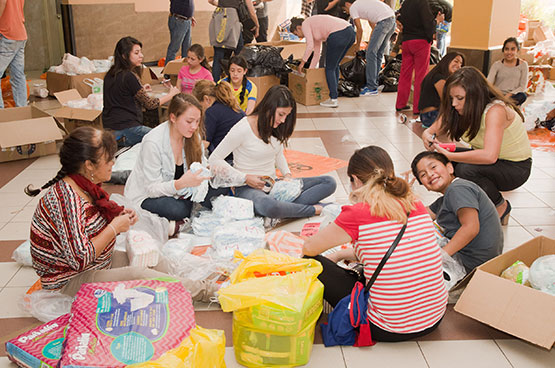Before a Disaster - Emergency Preparedness - 72 Hour Kit
Emergency Preparedness
There are real benefits to being prepared:
- Being prepared can reduce fear, anxiety, and losses that accompany disasters. Communities, families, and individuals should know what to do in the event of a fire and where to seek shelter during a powerful storm. They should be ready to evacuate their homes and take refuge in public shelters and know how to care for their basic medical needs.
- People also can reduce the impact of disasters (flood proofing, elevating a home or moving a home out of harm’s way, and securing items that could shake loose in an earthquake) and sometimes avoid the danger completely.
The need to prepare is real:
- Disasters disrupt hundreds of thousands of lives every year. Each disaster has lasting effects, both to people and property.
- If a disaster occurs in your community, local government and disaster-relief organizations will try to help you, but you need to be ready as well. Local responders may not be able to reach you immediately, or they may need to focus their efforts elsewhere.
- You should know how to respond to severe weather or any disaster that could occur in your area - hurricanes, earthquakes, extreme cold, flooding, or terrorism.
- You should also be ready to be self-sufficient for at least three days. This may mean providing for your own shelter, first aid, food, water, and sanitation.
Many large scale disasters could impact the availability of resupply or inclement conditions could prevent people from traveling safely to a store. For that reason, we greatly encourage citizens to have a larger supply of food, water, and medicine.
The 72 Hour Kit
There are many types of disasters and emergencies: fires, floods, earthquakes or man-made disasters. You and your family may need to survive on your own after an emergency. Having sufficient supplies such as food, water, medicine and emergency essentials is important. Local officials and relief workers will be on the scene after a disaster but they cannot reach everyone immediately. You could get help in hours or it might take days. It is estimated that after a major disaster, it may take up to three days for relief workers to reach some areas.
Additionally, basic services such as electricity, gas, water, sewage treatment and telephones may be cut off for days or even a week, or longer. Your supplies kit should contain items to help you manage during these outages.
At a minimum, all individuals and families should have at 72-Hour Kit (Basic Disaster Supplies Kit). Try to assemble your kit well in advance of an emergency. You may have to evacuate at a moment’s notice and take essentials with you. You will probably not have time to search for the supplies you need or shop for them.
The six basic groups of disaster supplies your should have in your home
- Water
- Food
- First aid supplies
- Clothing, bedding and sanitation supplies
- Tools
- Special items
Keep the items that you would most likely need during an evacuation in an easy-to-carry container. Possible storage containers include a large, covered trash container, a camping backpack, or a duffle bag.
Basic Disaster Supplies Kit
The following items are recommended for inclusion in your basic disaster supplies kit:
- A three-day supply of non-perishable food suitable for your family’s size
- A three-day supply of water – one gallon of water per person, per day
- Portable, battery-powered radio or television and extra batteries
- Flashlight and extra batteries
- First aid kit and manual
- Sanitation and hygiene items (moist towelettes and toilet paper)
- Matches and a waterproof container
- Whistle
- Extra clothing
- Kitchen accessories and cooking utensils, including a can opener
- Photocopies of credit and identification cards
- Cash and coins
- Special needs items, such as prescription medications, eye glasses, contact lens
- solution, and hearing aid batteries
- Items for infants, such as formula, diapers, bottles, and pacifiers
- Other items to meet your unique family needs
Living in a colder climate as we do, you must think about warmth. It is possible that you will not have heat. Think about your clothing and bedding supplies. Be sure to include one complete change of clothing and shoes per person, including:
- Jacket or coat
- Long pants
- Long sleeve shirt
- Sturdy shoes
- Hat, mittens, and scarf
- Sleeping bag or warm blanket (per person)
Maintaining your disaster supplies kit
Just as important as putting your supplies together is maintaining them so they are
safe to use when needed. Here are some tips to keep your supplies ready and in
good condition:
- Keep canned foods in a dry place where the temperature is cool.
- Store boxed food in tightly-closed plastic or metal containers to protect from
pests and to extend its shelf life. - Throw out any canned goods that become swollen, dented, or corroded.
- Use foods before they go bad, and replace them with fresh supplies.
- Place new items at the back of the storage area and older ones in the front.
- Change stored food and water supplies every six months. Be sure to write the
date you store it on all containers. - Re-think your needs every year and update your kit as your family needs
change. - Keep items in airtight plastic bags and put your entire disaster supplies kit in
one or two easy-to-carry containers, such as an unused trash can, camping
backpack, or duffel bag.



